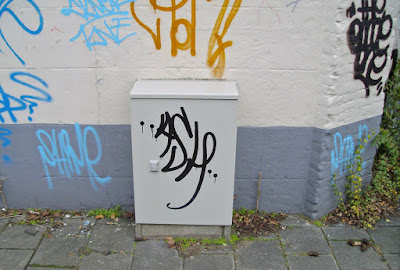Sorry for Damage Done
170 x 240 mm
352 page softcover
printed in monochrome
and full-colour offset
352 page softcover
printed in monochrome
and full-colour offset
language: English
edition: 1.000
edition: 1.000
978-94-92051-26-4
Often, the dull images are unintentionally exciting and amusing, or contain a fascinating play between the ‘before’ and ‘after’ states. Sometimes one can wonder about the need for cleaning when the results are not necessarily an improvement of the old situation. But luckily, one can also find severely degraded locations being neatly refurbished.
When the authors, Vincent Wittenberg and Wladimir Manshanden, stumbled upon this bizarre collection, they immediately appreciated its historic value. The database is a meticulous seven-year inventory of the graffiti and sticker culture in Eindhoven and exposes the city’s struggle with the ambivalence of combatting vandalism versus embracing subcultures. It also documents urban space as a territory where a wide range of people leave their mark.
Sorry for Damage Done represents three percent of the entire database: more than fifteen hundred chronologically ordered photographs of graffiti and their ‘cleaned-up’ counterparts.
Including the essay The Destruction of Non Art by Christian Omodeo, who reflects on the debate on the dividing line between art and vandalism.
About Vincent Wittenberg
Vincent Wittenberg is a socially engaged spacial designer. Through interventions he reacts on his environment in both conceptual as physical ways. His ‘products’ are catalysts or vehicles for change. He graduated from the Design Academy Eindhoven in 2009, and is currently an ambassador for desired spontaneous vegetation at Gewildgroei.
About Wladimir Manshanden
Wladimir Manshanden is a committed city dweller and street artist. He works under the pseudonym MANSHANDEN OP STRAAT, and aims to show the city of Eindhoven in a more friendly and poetic light. Together with photographer Rob Stolk, he often takes people on urban safari, touring around the city’s orphaned viaducts, hidden street art and other forgotten places.
See also
Watching my name go by & the Art of Dr. Rat Dutch Graffiti '70s & '80s Amsterdam
Views & Reviews (the faith of) Graffiti New York Amsterdam Lisbon Keith Haring Dr Rat Jon Naar Photography
AUTHOR: LAURA MALLONEE
11.17.1711:30 AM
THE HUMOR AND BEAUTY IN CAPTURING GRAFFITI CLEANUP
DESIGNER VINCENT WITTENBERG was at a seedy train station in the Dutch city of Eindhoven a few years ago when he noticed a man using a knife to scrape graffiti off a wall. Once finished, the guy pulled out his cellphone and snapped a pic. Wittenberg asked what he was up to, and the man explained he was a contractor tasked with cleaning up the station. Before-and-after images proved he did the job.
"I thought, ‘Wow, there must be thousands of these images for every station," Wittenberg says. "'There must be a huge archive.'"
Turns out, he was right: The city had a database of 50,000 photographs taken by janitors, all documenting the Sisyphean task of cleaning up the streets. Wittenberg highlights 1,500 of the best in Sorry for the Damage Done, a quirky book he co-curated with graffiti artist Wladimir Manshanden. "I really like this before-and-after—this struggle, this fight, this constant cleaning," he says.
Want to Look Famous? Just Photoshop Yourself With Marilyn Monroe and Andy Warhol
Eindhoven has a lively graffiti scene. It was one of the first European cities that embraced New York-style graffiti in the 1980s and appeared in the 1987 classic Spray Can Art. But in 2007, Wittenberg says, the city enacted a zero-tolerance policy against graffiti, hiring contractors to indiscriminately remove anything and everything illegally sprayed onto municipal property. Over the next six years, they purged Eindhoven of thousands of tags—and took even more photographs—before financial problems forced the city to scale back the program.
Wittenberg gained access to Eindhoven’s graffiti archive through Manshanden, who got a copy of it from the manager of the cleanup program in 2012. He finds it weirdly fascinating, capturing a strange equilibrium between the graffiti artists and those tasked with removing their work. "The cleaner doesn’t have work when there’s no graffiti," Wittenberg says, "and the graffiti artist doesn’t have work if there isn’t a clean surface."
He and Manshanden decided to compile the most interesting images into a book, following the tradition of artists like Erik Kessels, Peter Piller, and Hans-Peter Feldmann who elevate common, found imagery into art. Every day for 50 days last winter, they each combed through a thousand images, selecting their favorites and whittling down from there. "We really wanted to make a book a cleaning company might have in their office, like, 'Look, here's what we do,'" Wittenberg says.
Whether or not you view these banal, utilitarian images as art, there’s a subtle, poetic comedy to them. The cleaners often return to the same tunnel or train station or park multiple times to scrub away the new graffiti that's sprung up. “You can compare the fight against graffiti to the fight against weeds,” Wittenberg says. “It’s a never-ending story.”







































Geen opmerkingen:
Een reactie posten